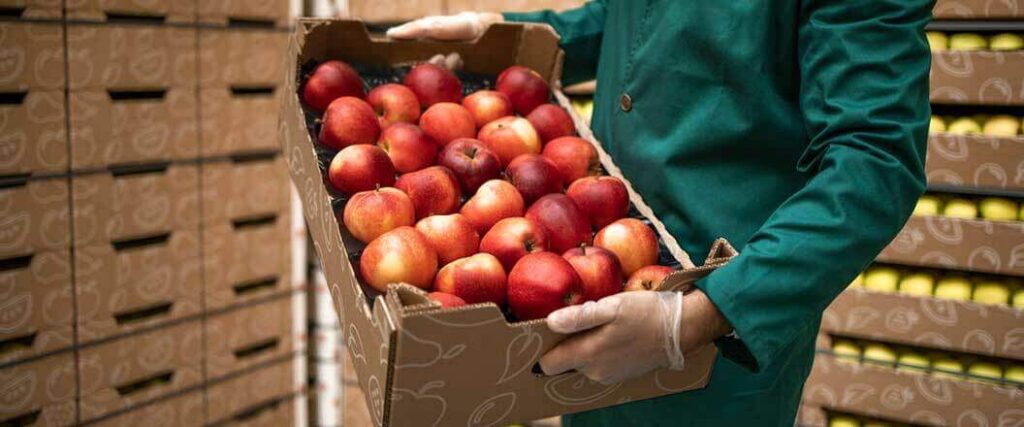Learning how to ship fresh produce is vital for any business in the agricultural sector. Transporting these goods comes with unique challenges, such as ensuring the delicate goods arrive at the final destination fresh and unspoiled. With the right tools at your disposal, you can move your fruits and vegetables with ease.
According to the International Institute of Refrigeration, fresh produce shipping should be completed with the following steps:
When a business ships their produce, they can expect to pay reefer transportation rates between $2.17 and $2.79 per mile.
Learn how to ship fresh produce correctly to guarantee successful transportation.
Transporting fresh produce can end in success or catastrophe. Therefore, businesses should follow each step carefully to ensure the quality of their goods during cold chain food distribution.
The first step is to plan the logistics of the load. Taking care of this before shipping produce will save businesses valuable time.
Things to consider include:
Fresh fruits and vegetables all have an expiration date, some of which are very short. By considering the transit time, agricultural companies can plan the best time to send goods. This also helps them determine the service level required for their products. Oftentimes, expedited fresh produce transport will be required.
There isn’t one temperature range that works for all fruits and vegetables. Companies should consider the conditions their specific load of produce will need to survive the journey. Finally, finding the right carrier is essential. You want to work with a company that has experience moving your type of produce successfully.
With the logistics planned out, agricultural companies should start checking the quality of their produce. Good produce will better withstand the rigors of transportation and satisfy customers.
Ensure you are sending quality products with the following steps:
Spoiled items should be removed to avoid damaging other pieces. Once produce passes all quality checks, shippers will be ready to package their goods.
Boxing and palletizing produce is a crucial part of the shipping process. Packaging goods correctly will help businesses beat many challenges that arise in cold chain logistics. Agricultural companies should use sturdy corrugated cardboard boxes for their produce.
If ventilation is needed, then shippers should pick boxes with holes. Next, choose a package size that fits the quantity of produce being transported. This prevents excess movement that can cause bruising. Shippers can use a regular 48” X 40” pallet to place their boxes on.
Other packing materials include:
Shippers should start packing by putting their fruits and vegetables into a plastic bag to maintain freshness. For smaller produce, the items can be placed in plastic containers. Afterward, the products should be distributed throughout the box evenly. If there’s any free space in the box, shippers can apply cushioning material.
This can include:
Gel packs are a great packing material that will help maintain the temperature inside the box. Now that produce is safely packed into each respective package, it’s time to palletize. Stack boxes using an overlapping stacking technique and make sure it goes no higher than 60 inches.
Next, apply shrink wrap around the load, starting from the base of the pallet and to the top of the stack. For items that need to be ventilated, this step may not be possible.
In such cases, straps are a great option for support. The final step is to put labels on the palletized load. Shippers should use at least two labels on opposing sides of the pallet fork entries.
After a produce shipment has been palletized, agricultural businesses can coordinate transportation services with a carrier. Companies should pick a shipping service level that will deliver their temperature controlled cargo before spoilage occurs. Once this is done, businesses will schedule a pickup time with their carrier.
Businesses can ready their shipment for pickup by:
Carriers require paperwork before shipping cargo. Therefore, it’s necessary to have all shipping documents ready for the transportation provider when they arrive. Next, the loading area must be cleared before the shipment is picked up. This means keeping the location free of obstructions to facilitate a smooth pickup process.
Once the goods are picked up by the carrier, you should track them carefully. Make sure from the start that your chosen carrier provides tracking services.
Real-time tracking allows businesses to keep tabs on their fruits and vegetables at any given moment. It can also be used to anticipate delays during the shipping process.
Customers want to know when their fresh produce will arrive. With tracking, agricultural companies can give their buyers updates about their shipment. Providing this simple service to customers will help build transparency and promote repeat business.
There are many regulations enforced by different federal agencies designed to ensure safety and quality. The vast majority of regulations involved in shipping fresh produce are put forth by the Food and Drug Administration (FDA).
Agricultural companies that are shipping fresh produce must become familiar with these rules. This will help shippers avoid breaking regulatory compliance
Previously, there was the 2005 Sanitary Food Transportation Act, required the FDA to ensure food doesn’t become adulterated when transported by motor vehicle or rail. That has since been updated.
Currently, sections of that act are incorporated into the broader Food Safety Modernization Act (FSMA). The FSMA has a section for the Sanitary Transportation of Human and Animal Food that details the required sanitary practices for shippers and other parties in the cold chain.
The FSMA rule has guidelines on the following:
Businesses that want to transport fresh produce will need to become familiar with the regulations set by the FSMA to ensure compliance and successful shipments.

The ultimate goal when shipping produce is keeping the goods as fresh and nutritious as possible. In the cold chain, there’s a variety of technology and packing techniques that are used to protect the integrity of these products.
The most important way that fruit and vegetables are kept fresh in the cold chain is with refrigeration systems. These devices are used in warehouses and reefer trailers. Refrigeration systems ensure goods are kept at the right temperature throughout the entire shipping process.
The cold chain relies on a variety of technologies besides simple refrigeration to ensure that produce stays fresh from the farm to the consumer.
This includes:
While refrigeration is critical when shipping fresh produce, these technologies and packing materials further guarantee the well-being of fruits and vegetables in transit.
If you’re shipping produce, you’ll need the services of a reefer carrier. Businesses can expect to pay a reefer rate between $2.17 and $2.79 per mile to transport their fruits and vegetables. These expenses can change based on the region of the country.
Rates will also fluctuate over time due to fuel costs and changes in demand for reefer services. Another factor that can influence the amount to ship produce is the volume of freight that’s transported. More cargo means higher costs for businesses.
While providing an exact expense is difficult, we’ve provided estimated shipping amounts for common fruits and vegetables.
| Produce | Cost To Ship One Pallet* |
| Apples | $450 |
| Grapes | $350 |
| Potatoes | $400 |
| Carrots | $375 |
| Oranges | $475 |
*Based on industry averages
When it comes to shipping palletized loads of produce, expenses can fluctuate based on the dimensions of cargo. Fortunately, many palletized loads of fruits and vegetables are similar in size. Therefore, costs will relatively the same.

Perishable goods like produce should only be left out of the cold chain for no more than two hours at room temperatures, and no more than one hour if the temperature is above 90℉.
Shippers should be very careful about leaving their fruits and vegetables out, especially during the summer months. To prevent this from happening, businesses simply need to keep their fruits and vegetables in a temperature controlled environment at all times.
This includes when:
The right temperature depends on the type of fruit or vegetable. Therefore, businesses will have to separate their produce accordingly before pickup takes place.
Master the cold chain in agriculture with our guide on this important process.
Fresh product transportation can be stressful for grocery stores and agricultural businesses. Fortunately, it doesn’t need to be. USA Refrigerated Freight can move your vegetables with ease. We have a network of carriers that provide top-of-the-line reefer transport.
Other products we can move include:
With USA Refrigerated Freight in your corner, your produce will arrive fresh and ready for consumption. Get started by calling our team at (866) 849-2713 or fill out your quote to get your freight moving.
USA Refrigerated Freight
315 NE 14th Street #4122
Ocala, FL 34470